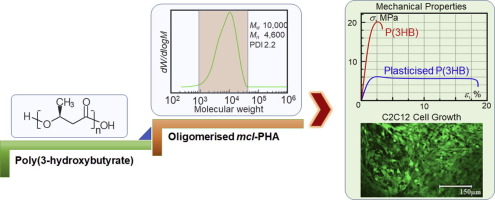Acta Biomaterialia ( IF 9.4 ) Pub Date : 2018-03-02 , DOI: 10.1016/j.actbio.2018.02.027 Barbara Lukasiewicz , Pooja Basnett , Rinat Nigmatullin , Rupy Matharu , Jonathan C. Knowles , Ipsita Roy

|
Progress in tissue engineering is dependent on the availability of suitable biomaterials. In an effort to overcome the brittleness of poly(3-hydroxybutyrate), P(3HB), a natural biodegradable polyester, and widen its biomedical applications, plasticising of P(3HB) with oligomeric substances of related structure has been studied. A biosynthesised medium-chain-length polyhydroxyalkanoate (mcl-PHA) copolymer, the plasticizer precursor, was obtained using vegetable waste frying oil as a sole carbon source. The mcl-PHA was transformed into an oligomeric derivative by acid hydrolysis. The plasticising effect of the oligomeric mcl-PHA on P(3HB) was studied via characterisation of thermal and mechanical properties of the blends in the course of ageing at ambient conditions. Addition of oligomeric mcl-PHA to P(3HB) resulted in softer and more flexible materials based entirely on PHAs. It was shown that the oligomeric mcl-PHA transformed highly crystalline P(3HB) into materials with a dominant amorphous phase when the content of oligomeric mcl-PHA exceeded 10wt%. In vitro biocompatibility studies of the new binary PHA materials showed high viability and proliferation of C2C12 myoblast cells. Thus, the proposed approach for P(3HB) plasticisation has the potential for the generation of more pliable biomaterials based on P(3HB) which can find application in unique soft tissue engineering applications where a balance between stiffness, tensile strength and ductility is required.
Statement of Significance
Polyhydroxyalkanoates, a broad family of natural biodegradable biocompatible polymers, have emerged as highly promising biomaterials both for bulk and biomedical applications. Here we describe an approach to tune the mechanical properties of stiff and brittle poly(3-hydroxybutyrate) and thereby to expand its potential biomedical applications. Plasticization, a common practice in the plastic industry to modify polymer mechanical properties, has been used very cautiously for biomedical applications due to plasticizer toxicity and migration. We have developed a plasticizer for poly(3-hydroxybutyrate) based on a structurally related but softer and pliable medium chain length polyhydroxyalkanoate. Additives of oligomeric derivatives of this polymer improved ductility of poly(3-hydroxybutyrate), greatly widening the future applicability of this well-established biomaterial. In parallel, the binary polyhydroxyalkanoate materials also exhibited improved cell attachment and proliferation, a highly desirable outcome.
中文翻译:

用于软组织工程的二元聚羟基链烷酸酯系统
组织工程学的进展取决于合适的生物材料的可用性。为了克服天然可生物降解聚酯聚(3-羟基丁酸酯)P(3HB)的脆性并扩大其生物医学应用,已经研究了P(3HB)与相关结构的低聚物质的增塑。使用植物废油炸油作为唯一碳源,获得了生物合成的中链长聚羟基链烷酸酯(mcl-PHA)共聚物,即增塑剂前体。通过酸水解将mcl-PHA转化为低聚衍生物。通过表征共混物在环境条件下的老化过程中的热和机械性能,研究了低聚mcl-PHA对P(3HB)的增塑作用。将低聚的mcl-PHA加到P(3HB)中,可以得到完全基于PHA的更柔软,更柔软的材料。结果表明,当低聚mcl-PHA的含量超过10wt%时,低聚mcl-PHA将高结晶度的P(3HB)转变为具有显性非晶相的材料。新的二元PHA材料的体外生物相容性研究表明,C2C12成肌细胞具有很高的生存能力和增殖能力。因此,所提出的P(3HB)塑化方法具有产生基于P(3HB)的更柔韧的生物材料的潜力,该材料可以用于需要平衡硬度,拉伸强度和延展性的独特软组织工程应用。
重要声明
聚羟基链烷酸酯是广泛的天然可生物降解的生物相容性聚合物家族,已成为用于散装和生物医学应用的极有前途的生物材料。在这里,我们描述了一种调整硬而脆的聚(3-羟基丁酸酯)的机械性能,从而扩展其潜在生物医学应用的方法。由于增塑剂的毒性和迁移,增塑是塑料工业中改变聚合物机械性能的常用方法,已非常谨慎地用于生物医学应用。我们已经开发了一种基于结构相关但较柔软且柔韧的中等链长的聚羟基链烷酸酯的聚(3-羟基丁酸酯)增塑剂。该聚合物的低聚物衍生物的添加剂改善了聚(3-羟基丁酸酯)的延展性,大大拓宽了这种成熟的生物材料的未来适用性。同时,二元聚羟基链烷酸酯材料还表现出改善的细胞附着和增殖,这是非常理想的结果。











































 京公网安备 11010802027423号
京公网安备 11010802027423号